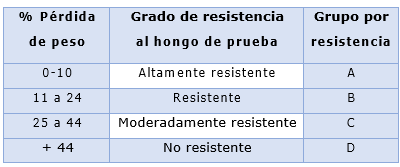Influence of two xylophagous fungi on the natural durability of ten timber species in Ucayali, Peru
Main Article Content
Abstract
Downloads
Article Details
References
AHN, Y.J., LEE, H.S., OH, H.S., KIM, H.T. y LEE, Y.H., 2005. Antifungal activity and mode of action of Galla rhois-derived phenolics against phytopathogenic fungi. En: Pesticide Biochemistry and Physiology, 81(2), pp. 105112. DOI: 10.1016/j.pestbp.2004.10.003
ANOUHE, J. B. S., NIAMKÉ, F.B., FAUSTIN, M., VIRIEUX, D., PIRAT, J.L., ADIMA, A.A., COULIBALY, S.K. y AMUSANT, N., 2018. The role of extractives in the natural durability of the heartwood of Dicorynia guianensis Amsh: new insights in antioxydant and antifungal properties. En: Annals of Forest Science, vol. 75, No. 1, pp. 5-15. DOI: https://doi.org/10.1007/s13595-018-0691-0
BRISCHKE, C. y MEYER-VELTRUP, L., 2016. Modelado de la descomposición de la madera causada por hongos de pudrición marrón. En: Materiales y estructuras, vol. 7, No. 2, pp. 89 - 95. DOI: https://doi.org/10.1080/20426445.2016.1160591
CALZADA B.J., 1985. Métodos estadísticos aplicados a la investigación. Editorial Jurídica, Lima, Perú.
CARTWRIGHT, K. Y FINDLAY, W., 1958. La decadencia de la madera y su prevención. En: LWW, Vol. 69, No. 5, pp. 415, 19481100130. Inglaterra.
COMISIÓN PANAMERICANA DE NORMAS TÉCNICAS, 1974. Descripción de características organolépticas, macroscópicas y microscópicas de la madera. Anteproyecto de Norma COPANT. Vol 30. pp. 119.
CRUZ C. R., CARRILLO PARRA, A. NÁJERA LUNA, J. A., CRUZ COBOS, F., HERNÁNDEZ, F.J. y MÉNDEZ GONZÁLEZ, J., 2018. Natural durability of wood of seven forest species of El Salto, Durango. En: Revista Mexicana de ciencias forestales, vol. 9, No. 46. DOI: http://dx.doi.org/10.29298/rmcf.v9i46.144
DOUROJEANNI R.M., 2016. Aprovechamiento del barbecho forestal en áreas de agricultura migratoria en la Amazonía Peruana. En: Revista forestal del Perú, vol. 14, No. 2. DOI: http://dx.doi.org/10.21704/rfp.v14i2.136
GONZÁLEZ V.F. E ICOCHEA, T.Y., 1980. Pudrición de la madera de diez especies forestales por acción de cinco hongos xilófagos. En: Revista Forestal del Perú, vol. 10, No. 1-2, pp. 1-38. Disponible en: http://cedinfor.lamolina.edu.pe/Articulos_RFP/Vol10_no1-2_80-81_(14) /vol10_art4.pdf
HABBOO, M. D., NOR, N.S.M. y IBRAHIM, N., 2018. Phytochemical content of hot and cold water extracts of Orthosiphon stamineus leaves. En: American Institute of Physics Conference Proceedings, Vol. 19, No. 4, pp. 20 - 67. DOI: https://doi.org/10.1063/1.5027982
LEHNEBACH, R., MOREL, H., BOSSU, J., LE MOGUÉDEC, G., AMUSANT, N., BEAUCHÊNE, J., Y NICOLINI, E., 2017. Heartwood/sapwood profile and the tradeoff between trunk and crown increment in a natural forest: the case study of a tropical tree (Dicorynia guianensis Amsh., Fabaceae). Trees, 31(1), 199-214. DOI:10.1007/s00468-016-1473-7
SANCHES, A.C., LOPES G.C., NAKAMURA V.C., DÍAS FILHO P.B. Y PALAZZO DE MELLO J.C., 2005. Actividades antioxidantes y antifúngicas de extractos y taninos condensados de Stryphnodendron obovatum Benth. En: Revista Brasileira De Ciencias Farmacéuticas, vol. 41, No. 1, pp. 101-107. Brasil. DOI: https://doi.org/10.1590/S1516-93322005000100012
SILVA-CASTRO, I., ALONSO CORTÉS, A., CASADOS SANZ, M., ACUÑA RELLO, L., MARTÍN RAMOS, P. Y MARTÍN GIL, J., 2016. Prevención y tratamiento de la pudrición blanca de la madera mediante recubrimientos basados en oligómeros de quitosano. En: 13º Congreso Nacional del Medio Ambiente (CONAMA), España. pp. 1-6. Disponible en: https://docplayer.es/89201804-Prevencion-y-tratamiento-de-la-pudricion-blanca-de-la-madera-mediante-recubrimientos-basados-en-oligomeros-de-quitosano.html
TAYLOR, A., GARTNER, B. y MORRELL, J., 2002. Heartwood formation and natural durability - a review. En: Wood and Fiber Science, vol. 34, No. 4, pp. 587611. Disponible en: https://www.researchgate.net/publication/41043844_Heartwood_formation_and_natural_durability_ -_A_review
TUEZTA GIACOMOTTI, J. y RODRÍGUEZ REYNEL, C., 2018. Mortalidad y reclutamiento de árboles en un bosque secundario tardío del valle de Chanchamayo, Perú. En: Revista Forestal del Perú, vol. 33, No. 1, pp. 42-51. DOI: http://dx.doi.org/10.21704/rfp.v33i1.1154


